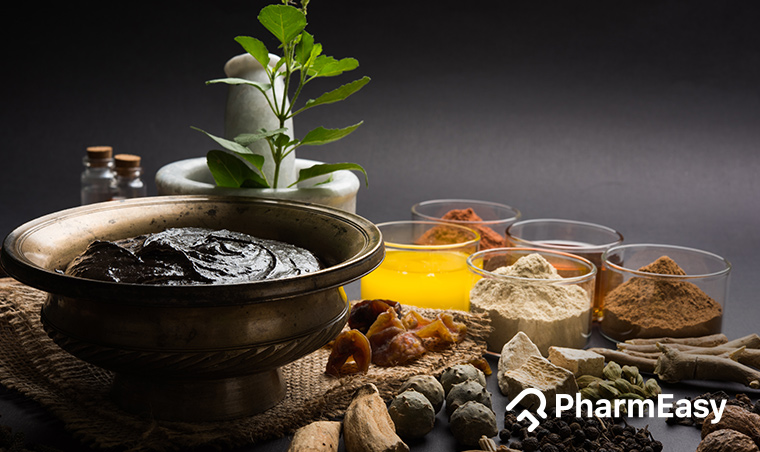Lakshadi Guggul – Uses, Benefits, Side effects & More!
By Dr Anuja Bodhare +2 more

Get,

to manage your symptom
Get your,


4 Cr+ families
benefitted

OTP sent to 9988776655



You’ve successfully subscribed to receive
doctor-approved tips on
Whatsapp

Get ready to feel your best.

Hi There,
Download the PharmEasy App now!!


Register to Avail the Offer
Send OTPBy continuing, you agree with our Privacy Policy and Terms and Conditions

Hi There,
Sign up on PharmEasy now!!
Trusted by 4 crore+ families

OTP sent to 9988776655



You have unlocked 25% off on medicines




Code: NU25
By Dr Anuja Bodhare +2 more
Table of Contents
Lakshadi guggul is a poly herb containing six different ingredients.1 The different ingredients are as follows:
Guggul is the major ingredient of lakshadhi guggul. 1 In Ayurvedic formulation, Lakshadi guggul is a solid dosage dispensed in the forms of tablets. 2

Did you know?
Lakshadi guggul contains different nutritional components like:
Asthishrinkhala Root powder contains various mineral resources including:4
Based on some research and my observations, Lakshadi guggul might be beneficial for managing skin ailments. Lac is present as one of the ingredients that might help in wound healing by stopping bleeding from injuries. Also, it might aid in the healing process of ulcers.
Dr. Siddharth Gupta, B.A.M.S, M.D (Ayu)
Laksha, ashwagandha, and arjuna found in Lakshadi Guggul possess anti-inflammatory properties and help in reducing swelling in rats in cases of fractures, osteoporosis, arthritis. 6
So, without any multivitamins or calcium, Lakshadi Guggul can be used for bone mending benefits.2
Also Read: Triphala Guggulu – Uses, Benefits & Side Effects
Lac present in Lakshadi Guggul is quite beneficial and exhibits various medicinal properties. For instance, it might be useful for weight reduction, heart rate reduction, provides bone strength, relief from bone pain, making dentures, etc.
Dr. Rajeev Singh, BAMS
Lakshadi guggul is available in the form of a tablet in the markets and it can be taken as a whole with water.3
Your physician will prescribe you the appropriate dosage based on your individual needs.
The tablets of lakshadi guggul are well-tolerated and do not show any major toxicity or side effects in the patients.5
Lakshadi guggul is known to increase calcium levels of the body. Hence, use with caution in case of hypercalcemia, as it can further increase the serum calcium levels. 2,5,6
Also Read: Lavender – Uses, Benefits & Side Effects
Lakshadi guggul may synergistically work along with calcium supplements and increase the calcium levels of the body and may cause hypercalcemia. Consult a doctor before co-administration of lakshadi guggul and calcium supplements. 2,5,6
Also Read: Manjistha – Uses, Benefits & Side Effects
Lakshadi Plaster can be used as a splint. The principal ingredient is Laksha, which contains Kashaya Rasa and Sheeta Veerya, which provide a soothing effect due to their Vedanasthapaka (painkiller) and Shothagna (anti-inflammatory) characteristics. Aside from that, Lakshadi Plaster is a suitable splint for immobilizing and stabilising damaged bones, which is essential for fracture healing.2 6
Some of the uses of Asthishrinkhala are diabetes, obesity, high cholesterol, allergies, cancer, malaria, stomach upset, asthma, wound healing, painful menstrual periods, peptic ulcer disease, bone fractures, weak bones (osteoporosis), and bodybuilding supplements, as an alternative to anabolic steroids.
Osteoarthritis, rheumatoid arthritis, and osteoporosis are all treated using this plant.
Bone fractures are treated with the roots and stems.
Asthma is treated with a stem paste.
The powdered herb is used to treat hemorrhoids and certain bowel infections.
Scurvy, debilitating menstruation diseases, otorrhoea, and epistaxis are all treated using stem juice.
Cattle are fed the herb to increase milk production.4
Guggul is used to treat ailments and has a significant role in Ayurveda, India’s traditional medicinal system. Guggul is a fat-burning herb that is also used to align bones. Arthritis, atherosclerosis (cholesterol in the artery wall), obesity, hyperlipidemia (increased cholesterol), rheumatism, haemorrhoids, urinary issues, skin diseases, neurodegeneration, Parkinson’s illness, Mongolism are some of the other beneficial effects of guggul. 7
There isn’t enough scientific data to support the usage of Lakshadi Guggul for hair and skin. An Ayurvedic practitioner can help you find the right dose for your hair problems.
The leaves of ashwagandha are used for blood purification, and the whole plant is utilised as a diuretic and antibiotic, especially in the treatment of gonorrhoea. Ethiopians, in particular, are said to utilise ashwagandha to treat cough, asthma, epilepsy, eye infections, scabies, and paralysis, as well as bad eyes and evil spirits. Furthermore, the Zay people of Ethiopia have been documented exclusively using ashwagandha to cure chest pain and typhoid. 8
Also Read: Shallaki – Uses, Benefits & Precautions
Also Read: Punarnavadi Mandoor – Uses, Benefits & Side Effects
Disclaimer: The information provided here is for educational/awareness purposes only and is not intended to be a substitute for medical treatment by a healthcare professional and should not be relied upon to diagnose or treat any medical condition. The reader should consult a registered medical practitioner to determine the appropriateness of the information and before consuming any medication. PharmEasy does not provide any guarantee or warranty (express or implied) regarding the accuracy, adequacy, completeness, legality, reliability or usefulness of the information; and disclaims any liability arising thereof.
Links and product recommendations in the information provided here are advertisements of third-party products available on the website. PharmEasy does not make any representation on the accuracy or suitability of such products/services. Advertisements do not influence the editorial decisions or content. The information in this blog is subject to change without notice. The authors and administrators reserve the right to modify, add, or remove content without notification. It is your responsibility to review this disclaimer regularly for any changes.

Leave your comment...
Comments